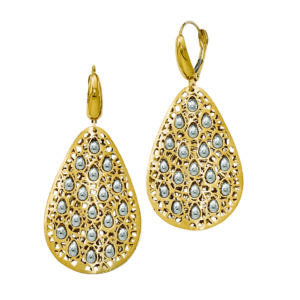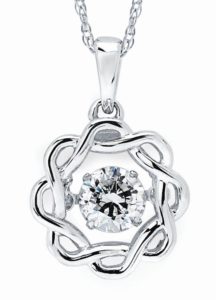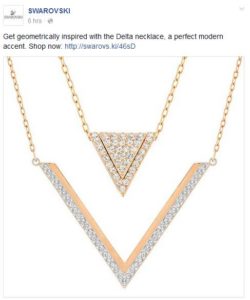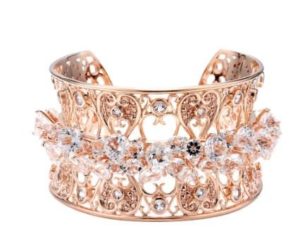Post Vegas Planning
Overwhelmed with all you saw and experienced at JCK, jewelers have much to sort through post the mega jewelry show in Las Vegas last month. While evaluating trends tracked in the context of your store and brand image, here are some takeaways jewelers can keep in mind to help make sense of it all.
 • Discuss trends tracked with sales staff and have associates assist in tracking and translation: “Not all trends hit all parts of the country at the same time,” says says Cora-Lee Colaizzi, director of marketing Quality Gold, Fairfield, Ohio. “Ask your staff what they are noticing. Get feedback from customers especially those who travel often. They’re exposed to products in some markets that haven’t yet become popular in others. And often youth are the earliest of adopters. Review what teens are wearing in your area. Don’t forget the celebrity influence. Many want to dress and wear accessories similar to the celebrities they identify with. Review merchandise/brand catalogs and select items that fill the trends identified and/or styling shown in the press and on social media followed by your target audience.”
• Discuss trends tracked with sales staff and have associates assist in tracking and translation: “Not all trends hit all parts of the country at the same time,” says says Cora-Lee Colaizzi, director of marketing Quality Gold, Fairfield, Ohio. “Ask your staff what they are noticing. Get feedback from customers especially those who travel often. They’re exposed to products in some markets that haven’t yet become popular in others. And often youth are the earliest of adopters. Review what teens are wearing in your area. Don’t forget the celebrity influence. Many want to dress and wear accessories similar to the celebrities they identify with. Review merchandise/brand catalogs and select items that fill the trends identified and/or styling shown in the press and on social media followed by your target audience.”
Find sales associates with a passion for fashion to follow and report on trends and how they relate to your merchandise and clientele. Follow Pantone’s predictions, and read jewelry trade and consumer lifestyle magazines in print and online that summarize what’s happening. Also, keep on your radar leading brands that invest in and share trends research with the industry like Swarovski and its Gem Visions forecast as to what they’re pushing. Use the Internet as a quick and easy way to track trends via a simple web search. Consider working with market research companies like MVI Marketing and its Jewelry Consumer Opinion Council to better understand trends in the context of your audience.
• Pick new styles to keep displays interesting and fresh; accessorize sales staff to elevate presentation: “Remain relevant by identifying a few signature pieces to gain attention and foster chatter,” says Colaizzi. “If windows and cases always look the same customers will stop looking. With the influx of digital messages and smart phones, the average attention span is less than eight seconds, so stores need to quickly make an impression through various channels to engage individuals.” She advises jewelers have associates model product and use trends to express their individual style within the store to foster interest among clients. “The customer may never notice the piece in the case, but seeing it worn on the sales associate makes the presentation different. The piece is now part of the personal interaction the associate is having with the customer. She can see how it wears and visualize how it will work within their lifestyle.”
• Pitch Your Top 10: Jewelers aren’t looking for more product, they’re looking for more customers, preaches Larry Johnson, merchandising consultant and author of Effective Jewelry Displays. Determine your top five or 10 gift ideas. Johnson, a merchandising consultant and author of The Complete Guide to Effective Jewelry Displays, is a proponent of jewelers helping their customers and sales staff with gift ideas to pitch that at the very least start the conversation and demonstrate that the associate has listened and understands the challenge and has some solutions. “With this strategy, you’ll not only make the customers search easier, you’ll find that sales staff will have more time to talk to people.” Jewelers can use this strategy for winter holidays, Valentine and Mother’s days.
Johnson was instrumental in establishing a program for the Minneapolis, Minnesota manufacturer Ostbye for its customers called Thru The Store. “One of the ways we’re helping our retailers sell through is presenting a Top 10 Program developed by Larry Johnson with gifts with price points that range from $99 to $2,499 in styles from sterling silver to stackable bands to diamond studs with a twist to minimalist styles, Shimmering Diamonds, and more,” says Sheila Johnson, merchandising manager. “We rolled out this strategy in mid-October. Sales of all the suggested 10 items were very strong and beat expectations. There were many instances of people spending up and buying bigger pieces prompted by the suggestions. Sales staff said the concept made their jobs easier by allowing them to offer good ideas earlier in the sales presentation.”
 • Switch to new point-of-sale and merchandising fixtures: “If something different is available since a line was brought into your store, make a switch to new displays and point-of-sale to draw attention and cultivate a renewed interest among customers, as well as sales associates,” advises Colaizzi. “Review brand web sites and catalogs for product information and host training refresher classes to highlight sales and benefits of each brand. Generate excitement by extending the exercise further in the form of a trivia game offering prizes and rewards for accurate responses.”
• Switch to new point-of-sale and merchandising fixtures: “If something different is available since a line was brought into your store, make a switch to new displays and point-of-sale to draw attention and cultivate a renewed interest among customers, as well as sales associates,” advises Colaizzi. “Review brand web sites and catalogs for product information and host training refresher classes to highlight sales and benefits of each brand. Generate excitement by extending the exercise further in the form of a trivia game offering prizes and rewards for accurate responses.”
• Build multiple channels of engagement: Retailers who want to be successful must have an omni-channel marketing strategy to reach consumers, particularly Millennials, who do most of their research online, cites Martin Hurwitz, CEO of MVI Marketing, San Luis Obispo, California. “Young consumers will never shop the way their parents and grandparents did. They’re mobile, social, and diverse. Four out of five consumers use smart phones and mobile devices to shop.”
Cheryl Jester, trend and communications manager for Swarovski in New York, citing trends from the brand’s Gem Visions 2016 report, notes that new retail environments are generating fresh jewelry experiences in line with the latest evolution of entertainments. “Spectacular new showrooms, galleries as well as luxury online platforms are redefining boundaries, creating interactive and personally relevant jewelry experiences.”
• Product origin is important: Your website and social media platforms are ideal avenues to make connections with customers without “selling” to them. Fresh content is key moving forward to keep consumers engaged. In addition to relating trends to your merchandise, consumers especially want to hear about the origin of the products they buy, says Jester, citing the “Made In” revolution a key direction in Gem Visions 2016. “Consumers increasingly demand that the luxuries they buy are produced with integrity. Sustainability and corporate responsibility are critically important and feature equally in product, project and corporate communications, as well as brand stories and collection themes.”
Colaizzi cites the power of “Made in America” and the big push for fine jewelry that’s not only designed but also manufactured in the U.S. “There remains continued interest in knowing where a product is made and in bringing manufacturing back to the USA, thus supporting locally designed and produced merchandise that creates jobs, supports families, and is smart business.”










